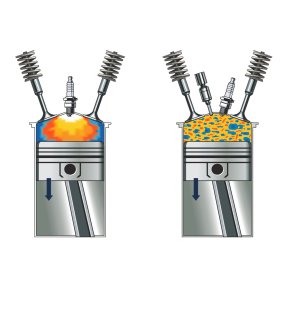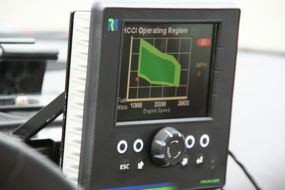Click on the HCCI equipped Opel Vectra for a high-res gallery
At the General Motors Proving Ground in Milford, MI on Friday, the company provided their first public presentation of HCCI engines. Most of the major automakers, in addition to researchers at universities around the world have been experimenting with HCCI for much of the last three decades and now it's finally driveable. As part of their 2007 Powertrain technology show, GM brought a Saturn Aura and an Opel Vectra, each equipped with a 2.2L HCCI engine.
Dr. Uwe Grebe gave the assembled media an introduction to HCCI before we got to drive. Ever since Karl Benz's first MotorWagen in 1886, automotive engines have been dominated by the four-stroke cycle which consists of intake, compression, power and exhaust. All four-strokes operate on the same basic principals of opening a valve and drawing in the intake mix as the piston descends and compressing that mixture as it goes back up. The air fuel mixture is then ignited which pushes the piston down as the mixture burns and expands and then the exhaust valve opens as piston goes up and pushes out the exhaust. The ignition part is one of places where things vary.
Read on after the jump to learn how HCCI fits into the process.
The video meant to be presented here is no longer available. Sorry for the inconvenience.
First up, Karl Benz introduced the spark ignition engine where a spark plug provides the ignition source that lights off the mixture of gasoline (or ethanol or any number of other fuels) that are mixed with air somewhere around the time that the piston reaches top dead center on the compression stroke. Next, Rudolf Diesel devised the compression ignition engine which eventually came to bear his name. A diesel has no spark plug. Instead it relies on the fact that as you compress a gas such as air temperature rises. If the compression ratio of the engine is raised high enough, the temperature reaches a point where the fuel will spontaneously combust.The video meant to be presented here is no longer available. Sorry for the inconvenience.
The video shows flame propagation in HCCI at the top and conventional spark ignition at the bottom
Because of the high compression ratios in a diesel, the engine must be more robust to withstand the loads and the temperature of the combustion tends to be high enough to cause the nitrogen in the air to react with the oxygen resulting in NOx. As the name implies, homogeneous charge compression ignition (HCCI) relies on the high temperatures generated by compressing the intake stream to cause the fuel to auto ignite just like a diesel. The difference is that an HCCI engine runs on gasoline (or ethanol) instead of diesel fuel and has a significantly lower compression ratio.

In order to have smooth, consistent performance with varying fuels the engine management system needs to be able to vary the valve timing and lift which allows the compression ratio to be adjusted. Determining how to adjust the fuel and valve control requires a pressure sensor in the combustion chamber as well as fuel sensor like the ones already used on flex-fuel engines.
Because HCCI works best at relatively constant, partial-load conditions, the HCCI engines being developed right now are actually combination engines that can run as either spark ignition or HCCI. At higher speeds or loads, the engine runs as a normal SI type and then transitions to HCCI when the conditions warrant. The control software required to reliably detect when to operate in either mode as well as transitioning between modes is extremely complex and requires a lot of development. Most of the hardware necessary required to produce HCCI/SI engines exists now and the main stumbling block is getting reliable, cost effective cylinder pressure sensors.
All of this technology results in an engine that approaches the efficiency of diesel engines at a significantly lower cost. An HCCI engine provides a fifteen percent boost in fuel economy and reduced emissions compared to a conventional SI engine using pretty much the same exhaust after-treatment systems.

On the test loop that we were able to drive, the transitions between SI and HCCI were largely transparent and far smoother than any of the current production hybrids when starting and stopping the engine. Performance felt pretty much the same as a regular Vectra or Aura. The only detectable difference was a slight audible ticking when the engine was in HCCI. The technology definitely works, the main problem now will be making the control software robust enough to deal with all real world weather, road and driver conditions.
It's critical to make sure that the fuel injection and valve timing and lift are managed correctly. If the fuel ignites too early, it can cause excessive noise or damage to the engine internals. If it happens too late, the engine can misfire or stall so the software and the cylinder pressure sensor have to be reliable. Currently GM is not giving a timeline for when HCCI engines will go into production, but it will probably be sooner rather than later.


Sign in to post
Please sign in to leave a comment.
Continue